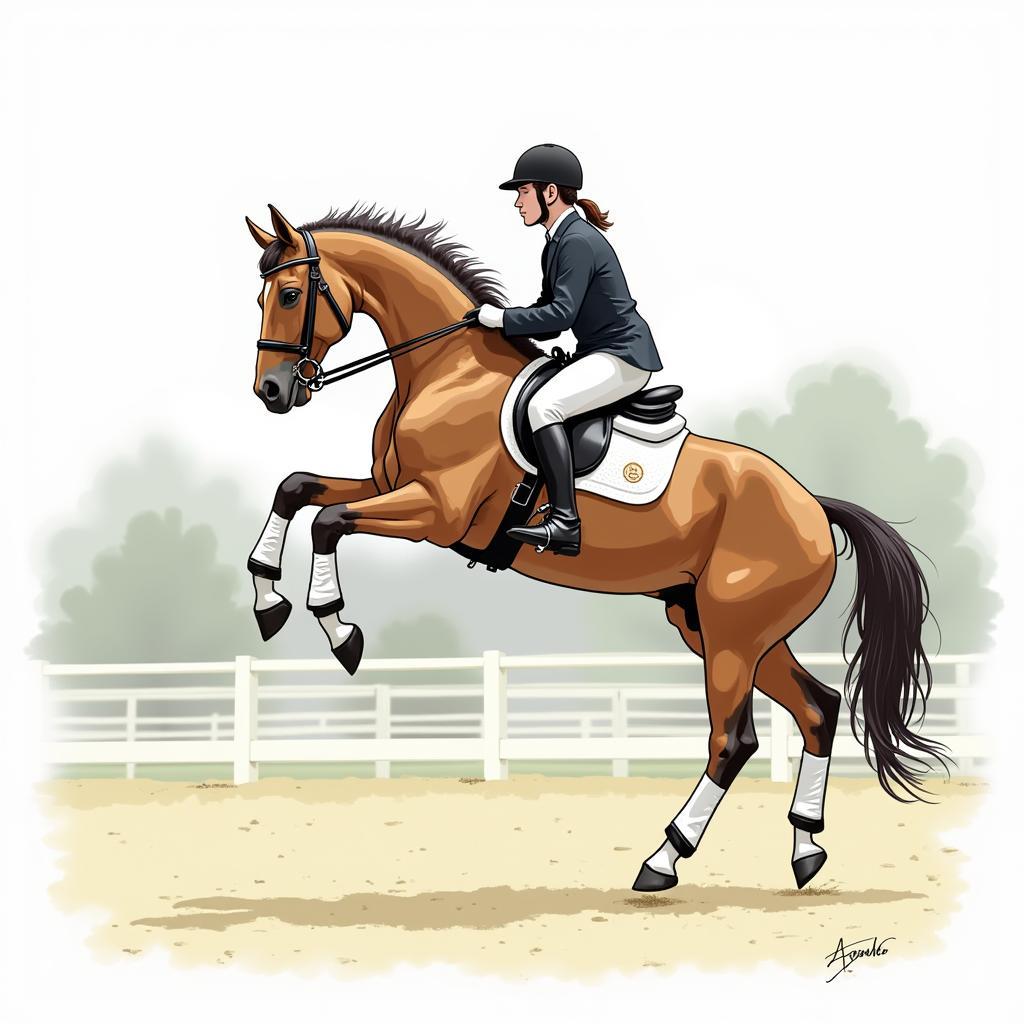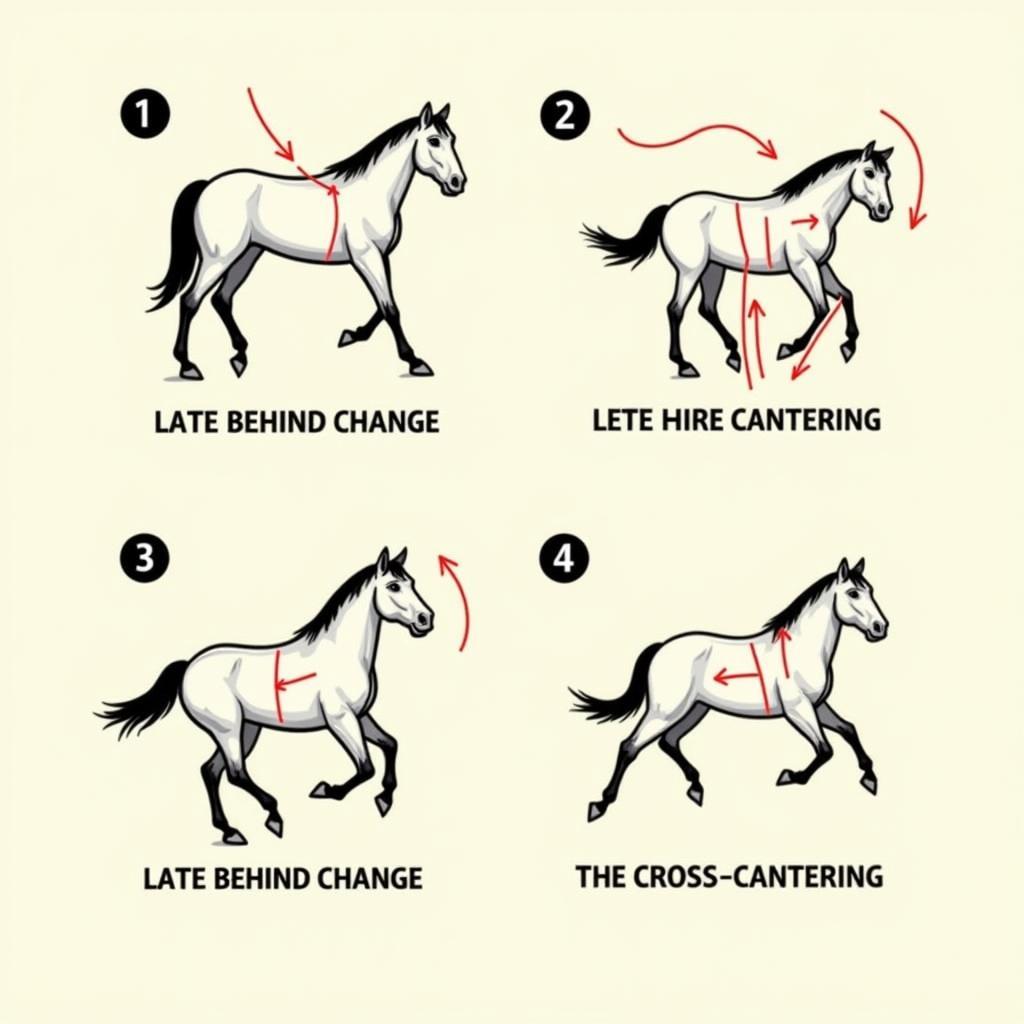Understanding how and when to cue a Horse Changing Leads is crucial for any rider, especially those involved in disciplines like western riding, dressage, and jumping. This guide will delve into the intricacies of this maneuver, offering practical advice and insights to help both horse and rider execute smooth, balanced lead changes.
A well-executed lead change isn’t just visually appealing; it’s essential for the horse’s balance, comfort, and overall performance. Whether you’re a seasoned competitor or a beginner, refining your lead change cues can significantly enhance your riding experience. This article will address common challenges, provide step-by-step instructions, and explain the biomechanics involved in this fundamental equestrian skill. We’ll explore everything from preparing your horse for lead changes to troubleshooting common issues, ensuring you have all the tools necessary to master this essential riding technique. Just after mastering changing leads, you can try to make your horse happy by learning new tricks.
What Does “Changing Leads” Mean in Horse Riding?
Changing leads refers to the horse switching which front and hind leg are leading on a circle or during a change of direction. For example, when cantering on the right rein, the horse’s right front and hind legs should be leading. When changing leads to the left rein, the horse switches to its left front and hind legs leading. This coordinated shift ensures balance and efficiency in movement. Lead changes are essential in many disciplines and demonstrate a high level of training and coordination between horse and rider.
Preparing Your Horse for Lead Changes
Before attempting a flying lead change, ensure your horse is balanced and responsive to your aids. Solid foundational training in basic transitions, like walk-trot and trot-canter, is crucial. Lateral work, such as leg yields and shoulder-in, helps develop the suppleness and responsiveness needed for smooth lead changes. Regular practice and consistency are key to building the muscle memory and coordination required for successful lead changes.
 Horse and Rider Practicing Lead Changes
Horse and Rider Practicing Lead Changes
Simple Lead Change Through the Walk
One effective method for teaching lead changes is the simple change through the walk. This involves cantering on one lead, transitioning down to a walk, straightening the horse, and then picking up the canter on the opposite lead. This method allows the horse to understand the concept of changing leads without the added complexity of the flying change. It’s an excellent starting point for young or inexperienced horses.
Flying Lead Changes: A Step-by-Step Guide
Once your horse understands the simple change, you can progress to flying lead changes. This advanced maneuver requires precise timing and coordination. Here’s a breakdown of the steps involved:
-
Establish a balanced canter: Ensure your horse is cantering rhythmically and on the correct lead.
-
Prepare for the change: Half-halt to rebalance and prepare your horse for the transition.
-
Cue the change: Simultaneously shift your weight to the new direction and apply your new outside leg slightly behind the girth. Your inside leg should maintain a light contact at the girth to prevent the horse from swinging its haunches out.
-
Maintain a steady rein contact: Keep a soft, consistent contact with the reins, supporting the horse through the change without restricting its movement.
 Rider Executing a Flying Lead Change
Rider Executing a Flying Lead Change
Troubleshooting Common Lead Change Problems
Even experienced riders encounter challenges with lead changes. Here are some common issues and how to address them:
-
Late behind: The horse changes the front legs but the hind legs lag. This is often caused by insufficient preparation or unclear aids. Focus on improving the horse’s responsiveness to your leg aids and ensuring a clear transition.
-
Cross-cantering: The horse canters with the front legs on one lead and the hind legs on the other. This is a serious balance issue and often stems from a lack of straightness. Work on improving straightness through exercises like shoulder-in and leg yields.
-
Resistance to changing leads: If your horse resists, ensure you aren’t anticipating the change and inadvertently giving conflicting cues. Stay relaxed and focused on maintaining clear, consistent aids.
For high-quality senior horse feed, check out our tribute senior horse feed. Proper nutrition is essential for maintaining your horse’s health and performance, especially as they age.
 Common Issues with Horse Lead Changes
Common Issues with Horse Lead Changes
Expert Insights on Horse Changing Leads
“Mastering lead changes takes time and patience,” says renowned equestrian coach, Sarah Mitchell. “Focus on developing a strong foundation in basic riding skills and work progressively towards flying changes. Remember that clear communication and consistent training are key to success.”
Conclusion
Mastering horse changing leads is an essential skill for any rider. By understanding the mechanics involved and applying consistent training techniques, you can help your horse execute smooth, balanced, and effortless lead changes, enhancing both your horse’s performance and your own riding experience. Remember, practice makes perfect! Don’t hesitate to seek guidance from a qualified instructor if you’re struggling with any aspect of this important maneuver. If you’re interested in buying a horse, check out our live stream of our blooded horse sale live stream.
FAQ
-
What age can a horse learn to change leads? Most horses can begin learning simple lead changes around 3-4 years old, with flying changes introduced later.
-
How often should I practice lead changes? Practice frequency depends on your horse’s fitness and experience level. Start with short sessions and gradually increase the duration and complexity.
-
What are the benefits of mastering lead changes? Lead changes improve the horse’s balance, agility, and overall performance.
-
Is it necessary for all disciplines? While essential for some disciplines like dressage and jumping, lead changes are also beneficial for other riding styles.
-
What if my horse struggles with lead changes? Consult with a qualified instructor to identify the root cause of the problem and develop a tailored training plan.
-
Can any horse learn flying lead changes? While most horses are physically capable, the ease of learning varies depending on conformation and temperament.
-
What is the difference between a simple and a flying lead change? A simple change involves a transition through walk, while a flying change is a seamless transition in the canter.
Common Scenarios for Asking About Horse Changing Leads:
- A rider is preparing for a dressage competition and needs to perfect their horse’s flying changes.
- A beginner rider is learning about lead changes for the first time.
- An experienced rider is having trouble with their horse consistently changing leads correctly.
- A horse owner is wondering when to start teaching their young horse about lead changes.
Further Resources on Justus Horses USA:
- Check out our other articles on horse training and care for more helpful tips.
- Explore our selection of horse products to find everything you need for your equine partner.
When you need support please contact Phone Number: 0772127271, Email: [email protected] Or visit us at: QGM2+WX2, Vị Trung, Vị Thuỷ, Hậu Giang, Việt Nam. We have a 24/7 customer service team.